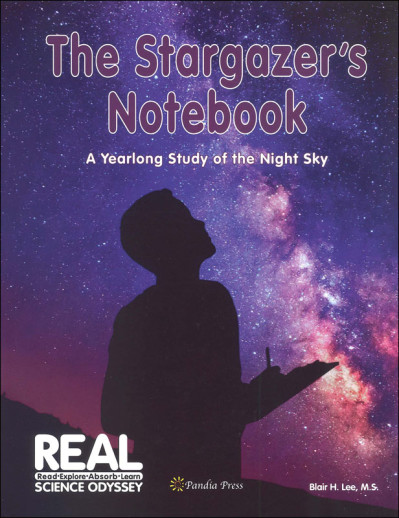We use cookies to make your experience better. To comply with the new e-Privacy directive, we need to ask for your consent to set the cookies. Learn more.
Stargazer's Notebook: Yearlong Study of the Night Sky
Whether you're in the Northern or Southern Hemisphere, spend a year learning about and chronicling constellations, planets, and stars. Includes sky maps, lab pages, and month-by-month necessary teaching directions. Document this monthly journey on detailed journal/lab pages. A QR code provides a free set of Night Sky Maps (not labs). Includes example Night Sky Maps, answer key and glossary.
This stargazers book is part stargazing journal and part astronomy lab, The Stargazer's Notebook provides the ideal instruction manual, planner, journal, and cosmos laboratory for the astronomy student, amateur stargazer, and anyone else wanting to learn more about the stars, planets, and celestial objects that occupy our skies.
Written by RSO Astronomy 2 author Blair Lee, the stargazers book: The Stargazer's Notebook can be used as an adjunct to a formal astronomy course or as a stand-alone study of the night sky. Once every month for a whole year, you will learn about an interesting aspect of the cosmos, such as the colors of the stars and why stars appear to "twinkle" in the sky. You will also spend an evening each month of the year studying the night sky and drawing what you see. You will chronicle the patterns and locations of constellations and their movement across the night sky. You will find planets, galaxies, and stars. You will even prove that Earth revolves around, or orbits, the sun and not the other way around. In addition, you will aim to see special night sky events as they occur. Your goal is to view and draw meteor showers, falling stars, and maybe even a lunar or solar eclipse. Is a comet coming your way? Are the planets in a special alignment at any time this year? If so, you will learn how to view and draw these events.
Included in the stargazers book:
- Step-by-step stargazing instructions
- 12 Night Sky Maps to record monthly observations
- 12 Night Sky Labs to study, model, and learn about the cosmos
- Planning tools, calendars, and checklists
- Instructions for the Northern Hemisphere and the Southern Hemisphere
Map the night sky:
- Learn how to stargaze using just your eyes
- Chronicle the patterns and locations of constellations
- Locate planets, galaxies, and stars
- View exciting cosmic events including meteor showers, eclipses, and auroras
- Map the sky to prove scientific theories and concepts
- Plenty of space in your journal for night sky drawing
Tactile and rigorous, this classically-based science program provides an excellent science experience. The program is designed for the non-science parent. If you are a squeamish person, R.E.A.L. Science may not be for you. You'll get dirty, handle bugs and worms, and learn through experimentation. The lessons in the book are intended to be done in order from start to finish, each lesson building upon the previous lessons. Two levels are available, perfect for multi-age learning or homeschool co-ops. The all-in-one text for Level One teaches science in an entertaining story-like format with hands-on activities, along with background science information, instructions, reading lists, journaling ideas, and supplemental websites. Student Worksheets are reproducible in Level One, although Student Pages are available separately. Science is planned 2-3 times per week. Formatted for independent learning, Level Two student texts bring science alive by engaging young people's minds through active participation in learning. Spiral bound Student Texts offer instruction and consumable activity sheets and review pages. Consumable student materials are available separately. Teacher Guides are recommended and include weekly schedules, learning goals, math concepts for labs, lesson reviews with information not found in the student book, lab material lists, answer keys and grading guidelines.
Basics of astronomy, the Big Bang, Stars, Formation of the Solar System, Planetary Motion, Rocky planets, Gassy planets, Mapping, Earth Day, and the Moon.
| Product Format: | Paperback |
|---|---|
| Brand: | Pandia Press |
| Grades: | 5-AD |
| ISBN: | 9780997796353 |
| Length in Inches: | 11 |
| Width in Inches: | 8.5 |
| Height in Inches: | 0.25 |
| Weight in Pounds: | 0.55 |

